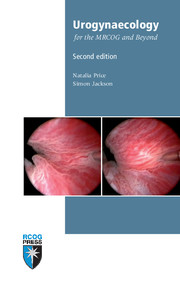Book contents
- Frontmatter
- Contents
- Preface
- Abbreviations
- 1 Applied anatomy and physiology of the lower urinary tract
- 2 Definition and prevalence of urinary incontinence
- 3 Initial assessment of lower urinary tract symptoms
- 4 Further investigation of lower urinary tract symptoms
- 5 Management of stress urinary incontinence
- 6 Management of overactive bladder syndrome
- 7 Recurrent urinary tract infection
- 8 Haematuria
- 9 Painful bladder syndrome and interstitial cystitis
- 10 Pregnancy and the renal tract
- 11 Ageing and urogenital symptoms
- 12 Fistulae and urinary tract injuries
- 13 Pelvic organ prolapse
- 14 Colorectal disorders
- 15 Obstetric anal sphincter injuries
- Index
9 - Painful bladder syndrome and interstitial cystitis
Published online by Cambridge University Press: 05 July 2014
- Frontmatter
- Contents
- Preface
- Abbreviations
- 1 Applied anatomy and physiology of the lower urinary tract
- 2 Definition and prevalence of urinary incontinence
- 3 Initial assessment of lower urinary tract symptoms
- 4 Further investigation of lower urinary tract symptoms
- 5 Management of stress urinary incontinence
- 6 Management of overactive bladder syndrome
- 7 Recurrent urinary tract infection
- 8 Haematuria
- 9 Painful bladder syndrome and interstitial cystitis
- 10 Pregnancy and the renal tract
- 11 Ageing and urogenital symptoms
- 12 Fistulae and urinary tract injuries
- 13 Pelvic organ prolapse
- 14 Colorectal disorders
- 15 Obstetric anal sphincter injuries
- Index
Summary
Painful bladder syndrome (PBS) is categorised by suprapubic pain related to bladder filling, accompanied by other symptoms such as increased daytime and night-time frequency in the absence of proven urinary tract infection or other pathology. The International Continence Society believes this to be a preferable term to interstitial cystitis. In the past, the two terminologies have been used interchangeably.
Painful bladder syndrome (Table 9.1) encompasses a much broader range of causes that need to be excluded, such as carcinoma in situ and endometriosis. There is considerable overlap between the overactive bladder syndrome (OAB), the urethral pain syndrome (urethral syndrome) and PBS. Whereas the principal complaint of women with OAB is urgency, in women with PBS it is predominantly pain related to bladder filling. Women with urethral pain syndrome, on the other hand, complain of pain on voiding. The term PBS, therefore, includes cases with painful urinary symptoms that may not meet the strictest definition of interstitial cystitis. The terminterstitial cystitis is used alone when describing cases that meet all of the interstitial cystitis criteria established by the US National Institute of Diabetes and Digestive and Kidney Diseases (NIDDK) (see box overleaf) and is a diagnosis of exclusion.
Interstitial cystitis is a chronic inflammatory disorder of the bladder and one of the causes of PBS first described by Hunner in 1915. It results in consistently low quality of life scores, is notoriously difficult to manage and can cause considerable morbidity.
- Type
- Chapter
- Information
- Urogynaecology for the MRCOG and Beyond , pp. 71 - 82Publisher: Cambridge University PressPrint publication year: 2012

